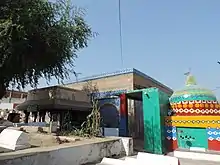Jahaniyan Jahangasht
Mīr Sayyid Jalāl ad-Dīn an-Naqwī al-Bukhārī (Persian: میر سید جلال الدین النقوی البخاری; 1308-1384), better known as Jahāniyān Jahāngasht (Persian: مخدوم جہانیاں جہان گشت), was a Sufi saint from South Asia.
Jahaniyan Jahangasht | |
|---|---|
 | |
| Personal | |
| Born | Mir Sayyid Jalaluddin 8 February 1308 |
| Died | 3 February 1384 (aged 76) |
| Religion | Islam |
| Sect | Sunni Islam |
| Jurisprudence | Hanafi |
| Relatives | Jalaluddin Surkh-Posh (grandfather) Shah Jewna (nephew) |
Biography


Mir Sayyid Makhdoom Jalaluddin Naqvi Al Bukhari was born into a Muslim family on 8th February 1308 AD (14 Shaban 707 AH). His father, Syed Ahmed Kabir, was the youngest son and chosen successor of Jalaluddin Surkh-Posh of Bukhara.[1]
He was later given the title of Jahaniyan Jahangasht from which he gained prominence. He travelled to many countries, and visited Mecca 36 times in his life. He married the daughter of his half-uncle Sadruddin Muhammad Ghawth.[2]
He visited Hazrat Pandua, the first capital of the Bengal Sultanate, where he led the janazah of Alaul Haq Pandwi, the court scholar of Bengal. Some of his gifts to Bengal include a Jhanda which is preserved in the dargah of Jalaluddin Tabrizi in Pandua and a Qadam Rasul at the Qadam Rasul Mosque in Gaur. The nearby Jhan Jhaniya Mosque of the 16th-century is said to be named in his honour too.[3] Every year, during the urs of Akhi Siraj Bengali, Jahangasht's jhanda is taken from Tabrizi's dargah to Akhi Siraj's mausoleum.[4]
Legacy

His descendants use the surname Naqvi Bukhari, and belong to the Naurang Jahania family Some of them migrated to Tando Jahania in Sindh creating a sizeable community, whilst others migrated to many other places within the subcontinent.[5][6][7][8]
See also
References
- Marat-e-Jalali (مرآت جلالی) by Syed Khalil Ahmed Bukhari Hassami, First Edition 1918, Allahabad, Second Edition 1999, Karachi.
- Hassami S. K. A. B. Marat-e-Jalali (Red Clothed man from Bukhara) First Edition 1918, Allahabad, Second Edition 1999, Karachi.
- Abdul Karim (2012). "Shaikh Akhi Sirajuddin Usman (R)". In Sirajul Islam; Miah, Sajahan; Khanam, Mahfuza; Ahmed, Sabbir (eds.). Banglapedia: the National Encyclopedia of Bangladesh (Online ed.). Dhaka, Bangladesh: Banglapedia Trust, Asiatic Society of Bangladesh. ISBN 984-32-0576-6. OCLC 52727562. OL 30677644M. Retrieved 26 October 2023.
- "Safarnama Makhdoom Jahanian Jahangasht". Archived from the original on 9 November 2013. Retrieved 19 October 2020.
- "UCH Sharif Trust | Understanding of Culture and Heritage | an Ancient Tradition". Archived from the original on 18 May 2016. Retrieved 25 July 2014.
- "Sufis & Shaykhs - World of Tasawwuf". Spiritualfoundation.net. Archived from the original on 14 July 2020. Retrieved 15 July 2013.
- UNESCO World Heritage Centre. "Tomb of Bibi Jawindi, Baha'al-Halim and Ustead and the Tomb and Mosque of Jalaluddin Bukhari - UNESCO World Heritage Centre". Whc.unesco.org. Retrieved 15 July 2013.